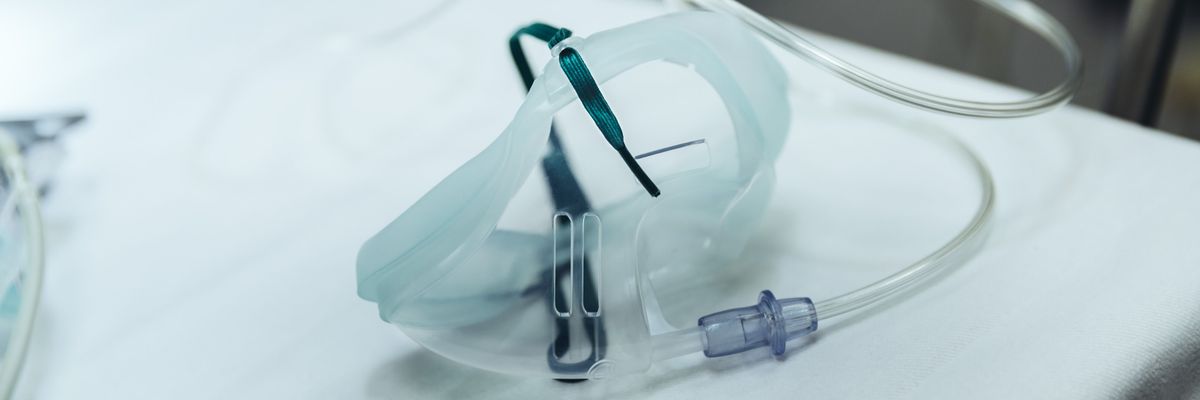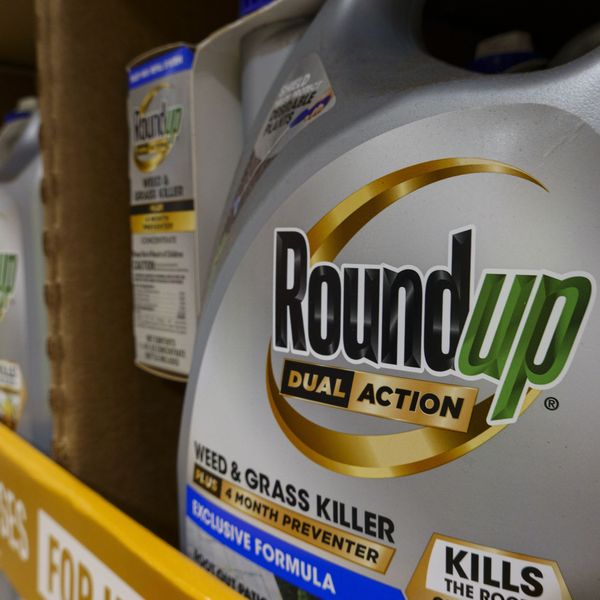
Alabama put a mask like this on the face of Anthony Boyd and pumped his body full of nitrogen gas in order to kill him on Thursday, October 24, 2025.
'Now Imagine... You Are Suffocating': Sotomayor's Graphic Dissent Over Nitrogen Gas Execution
The liberal justice accused the majority of turning their back "on the Eighth Amendment’s guarantee against cruel and unusual punishment."
US Supreme Court Justice Sonia Sotomayor was unable to convince the right-wing majority of the nation's highest court on Thursday night to accept a last-ditch petition from a man slated to be killed by the state of Alabama asking that he be put to death by firing squad as opposed to the more brutal and painful method of asphyxiation from nitrogen gas, a torturous process of execution experts have said amounts to cruel and unusual punishment.
Anthony Boyd, convicted of a 1993 murder and kidnapping, which he maintained until the end that he did not commit, was put to death by the state of Alabama using nitrogen gas after a request for a stay of execution and a review of a lower appeals court ruling was rejected in a 6-3 decision.
In the first four paragraphs of her dissent, backed by Justices Elana Kagan and Ketanji Brown Jackson, Sotomayor departed from the majority by asking people to put themselves inside the death chamber with the mask of nitrogen strapped to their face:
Take out your phone, go to the clock app, and find the stopwatch. Click start. Now watch the seconds as they climb. Three seconds come and go in a blink. At the thirty-second mark, your mind starts to wander. One minute passes, and you begin to think that this is taking a long time. Two . . . three . . . . The clock ticks on. Then, finally, you make it to four minutes. Hit stop.
Now imagine for that entire time, you are suffocating. You want to breathe; you have to breathe. But you are strapped to a gurney with a mask on your face pumping your lungs with nitrogen gas. Your mind knows that the gas will kill you. But your body keeps telling you to breathe.
That is what awaits Anthony Boyd tonight. For two to four minutes, Boyd will remain conscious while the State of Alabama kills him in this way. When the gas starts flowing, he will immediately convulse. He will gasp for air. And he will thrash violently against the restraints holding him in place as he experiences this intense psychological tor- ment until he finally loses consciousness. Just short of twenty minutes later, Boyd will be declared dead.
Boyd asks for the barest form of mercy: to die by firing squad, which would kill him in seconds, rather than by a torturous suffocation lasting up to four minutes. The Constitution would grant him that grace. My colleagues do not. This Court thus turns its back on Boyd and on the Eighth Amendment’s guarantee against cruel and unusual punishment. Because the Court should have instead granted a stay of execution and Boyd’s petition for certiorari, I respectfully dissent.
Last year, a body of experts at the United Nations urgently pleaded with US officials to put a stop to the death penalty by nitrogen hypoxia, calling it "clearly prohibited under international law." The experts cited the killing of Kenneth Smith by the state of Alabama in February of 2024 as the "first person ever to be executed in this way," a death which reportedly took more than 20 minutes as Smith "writhed and convulsed on the gurney."
The wife of another man executed by this method—approved by seven states, but only put to use so far by Alabama and Louisiana—said watching her husband be killed this way was like “watching someone drown without water.”
Citing the seven times the method had been used before Boyd, Sotomayor said there is now a clear record of the intense pain and unnecessary suffering experienced by people put to death in this manner. All the killings, she wrote, resulted in a similar experience: "apparent consciousness for minutes, not seconds; and violent convulsing, eyes bulging, consistent thrashing against the restraints, and clear gasping for the air that will not come."
While the Eighth Amendment of the US Constitution “does not guarantee a prisoner a painless death," argued Sotomayor, "when a State introduces an experimental method of execution that superadds psychological terror as a necessary feature of its successful completion, courts should enforce the Eighth Amendment’s mandate against cruel and unusual punishment."
She called for Boyd to be spared the excruciating death, given that a less cruel and painful alternative was readily available, and an end to the use of nitrogen hypoxia nationwide. While Kagan and Jackson agreed, the other six justices allowed the execution to proceed.
Before he was killed, according to CBS News, Boyd pleaded his innocence for a final time on Thursday. "I didn’t kill anybody. I didn’t participate in killing anybody,” he said. “There can be no justice until we change this system.”
An Urgent Message From Our Co-Founder
Dear Common Dreams reader, The U.S. is on a fast track to authoritarianism like nothing I've ever seen. Meanwhile, corporate news outlets are utterly capitulating to Trump, twisting their coverage to avoid drawing his ire while lining up to stuff cash in his pockets. That's why I believe that Common Dreams is doing the best and most consequential reporting that we've ever done. Our small but mighty team is a progressive reporting powerhouse, covering the news every day that the corporate media never will. Our mission has always been simple: To inform. To inspire. And to ignite change for the common good. Now here's the key piece that I want all our readers to understand: None of this would be possible without your financial support. That's not just some fundraising cliche. It's the absolute and literal truth. We don't accept corporate advertising and never will. We don't have a paywall because we don't think people should be blocked from critical news based on their ability to pay. Everything we do is funded by the donations of readers like you. Will you donate now to help power the nonprofit, independent reporting of Common Dreams? Thank you for being a vital member of our community. Together, we can keep independent journalism alive when it’s needed most. - Craig Brown, Co-founder |
US Supreme Court Justice Sonia Sotomayor was unable to convince the right-wing majority of the nation's highest court on Thursday night to accept a last-ditch petition from a man slated to be killed by the state of Alabama asking that he be put to death by firing squad as opposed to the more brutal and painful method of asphyxiation from nitrogen gas, a torturous process of execution experts have said amounts to cruel and unusual punishment.
Anthony Boyd, convicted of a 1993 murder and kidnapping, which he maintained until the end that he did not commit, was put to death by the state of Alabama using nitrogen gas after a request for a stay of execution and a review of a lower appeals court ruling was rejected in a 6-3 decision.
In the first four paragraphs of her dissent, backed by Justices Elana Kagan and Ketanji Brown Jackson, Sotomayor departed from the majority by asking people to put themselves inside the death chamber with the mask of nitrogen strapped to their face:
Take out your phone, go to the clock app, and find the stopwatch. Click start. Now watch the seconds as they climb. Three seconds come and go in a blink. At the thirty-second mark, your mind starts to wander. One minute passes, and you begin to think that this is taking a long time. Two . . . three . . . . The clock ticks on. Then, finally, you make it to four minutes. Hit stop.
Now imagine for that entire time, you are suffocating. You want to breathe; you have to breathe. But you are strapped to a gurney with a mask on your face pumping your lungs with nitrogen gas. Your mind knows that the gas will kill you. But your body keeps telling you to breathe.
That is what awaits Anthony Boyd tonight. For two to four minutes, Boyd will remain conscious while the State of Alabama kills him in this way. When the gas starts flowing, he will immediately convulse. He will gasp for air. And he will thrash violently against the restraints holding him in place as he experiences this intense psychological tor- ment until he finally loses consciousness. Just short of twenty minutes later, Boyd will be declared dead.
Boyd asks for the barest form of mercy: to die by firing squad, which would kill him in seconds, rather than by a torturous suffocation lasting up to four minutes. The Constitution would grant him that grace. My colleagues do not. This Court thus turns its back on Boyd and on the Eighth Amendment’s guarantee against cruel and unusual punishment. Because the Court should have instead granted a stay of execution and Boyd’s petition for certiorari, I respectfully dissent.
Last year, a body of experts at the United Nations urgently pleaded with US officials to put a stop to the death penalty by nitrogen hypoxia, calling it "clearly prohibited under international law." The experts cited the killing of Kenneth Smith by the state of Alabama in February of 2024 as the "first person ever to be executed in this way," a death which reportedly took more than 20 minutes as Smith "writhed and convulsed on the gurney."
The wife of another man executed by this method—approved by seven states, but only put to use so far by Alabama and Louisiana—said watching her husband be killed this way was like “watching someone drown without water.”
Citing the seven times the method had been used before Boyd, Sotomayor said there is now a clear record of the intense pain and unnecessary suffering experienced by people put to death in this manner. All the killings, she wrote, resulted in a similar experience: "apparent consciousness for minutes, not seconds; and violent convulsing, eyes bulging, consistent thrashing against the restraints, and clear gasping for the air that will not come."
While the Eighth Amendment of the US Constitution “does not guarantee a prisoner a painless death," argued Sotomayor, "when a State introduces an experimental method of execution that superadds psychological terror as a necessary feature of its successful completion, courts should enforce the Eighth Amendment’s mandate against cruel and unusual punishment."
She called for Boyd to be spared the excruciating death, given that a less cruel and painful alternative was readily available, and an end to the use of nitrogen hypoxia nationwide. While Kagan and Jackson agreed, the other six justices allowed the execution to proceed.
Before he was killed, according to CBS News, Boyd pleaded his innocence for a final time on Thursday. "I didn’t kill anybody. I didn’t participate in killing anybody,” he said. “There can be no justice until we change this system.”
US Supreme Court Justice Sonia Sotomayor was unable to convince the right-wing majority of the nation's highest court on Thursday night to accept a last-ditch petition from a man slated to be killed by the state of Alabama asking that he be put to death by firing squad as opposed to the more brutal and painful method of asphyxiation from nitrogen gas, a torturous process of execution experts have said amounts to cruel and unusual punishment.
Anthony Boyd, convicted of a 1993 murder and kidnapping, which he maintained until the end that he did not commit, was put to death by the state of Alabama using nitrogen gas after a request for a stay of execution and a review of a lower appeals court ruling was rejected in a 6-3 decision.
In the first four paragraphs of her dissent, backed by Justices Elana Kagan and Ketanji Brown Jackson, Sotomayor departed from the majority by asking people to put themselves inside the death chamber with the mask of nitrogen strapped to their face:
Take out your phone, go to the clock app, and find the stopwatch. Click start. Now watch the seconds as they climb. Three seconds come and go in a blink. At the thirty-second mark, your mind starts to wander. One minute passes, and you begin to think that this is taking a long time. Two . . . three . . . . The clock ticks on. Then, finally, you make it to four minutes. Hit stop.
Now imagine for that entire time, you are suffocating. You want to breathe; you have to breathe. But you are strapped to a gurney with a mask on your face pumping your lungs with nitrogen gas. Your mind knows that the gas will kill you. But your body keeps telling you to breathe.
That is what awaits Anthony Boyd tonight. For two to four minutes, Boyd will remain conscious while the State of Alabama kills him in this way. When the gas starts flowing, he will immediately convulse. He will gasp for air. And he will thrash violently against the restraints holding him in place as he experiences this intense psychological tor- ment until he finally loses consciousness. Just short of twenty minutes later, Boyd will be declared dead.
Boyd asks for the barest form of mercy: to die by firing squad, which would kill him in seconds, rather than by a torturous suffocation lasting up to four minutes. The Constitution would grant him that grace. My colleagues do not. This Court thus turns its back on Boyd and on the Eighth Amendment’s guarantee against cruel and unusual punishment. Because the Court should have instead granted a stay of execution and Boyd’s petition for certiorari, I respectfully dissent.
Last year, a body of experts at the United Nations urgently pleaded with US officials to put a stop to the death penalty by nitrogen hypoxia, calling it "clearly prohibited under international law." The experts cited the killing of Kenneth Smith by the state of Alabama in February of 2024 as the "first person ever to be executed in this way," a death which reportedly took more than 20 minutes as Smith "writhed and convulsed on the gurney."
The wife of another man executed by this method—approved by seven states, but only put to use so far by Alabama and Louisiana—said watching her husband be killed this way was like “watching someone drown without water.”
Citing the seven times the method had been used before Boyd, Sotomayor said there is now a clear record of the intense pain and unnecessary suffering experienced by people put to death in this manner. All the killings, she wrote, resulted in a similar experience: "apparent consciousness for minutes, not seconds; and violent convulsing, eyes bulging, consistent thrashing against the restraints, and clear gasping for the air that will not come."
While the Eighth Amendment of the US Constitution “does not guarantee a prisoner a painless death," argued Sotomayor, "when a State introduces an experimental method of execution that superadds psychological terror as a necessary feature of its successful completion, courts should enforce the Eighth Amendment’s mandate against cruel and unusual punishment."
She called for Boyd to be spared the excruciating death, given that a less cruel and painful alternative was readily available, and an end to the use of nitrogen hypoxia nationwide. While Kagan and Jackson agreed, the other six justices allowed the execution to proceed.
Before he was killed, according to CBS News, Boyd pleaded his innocence for a final time on Thursday. "I didn’t kill anybody. I didn’t participate in killing anybody,” he said. “There can be no justice until we change this system.”

